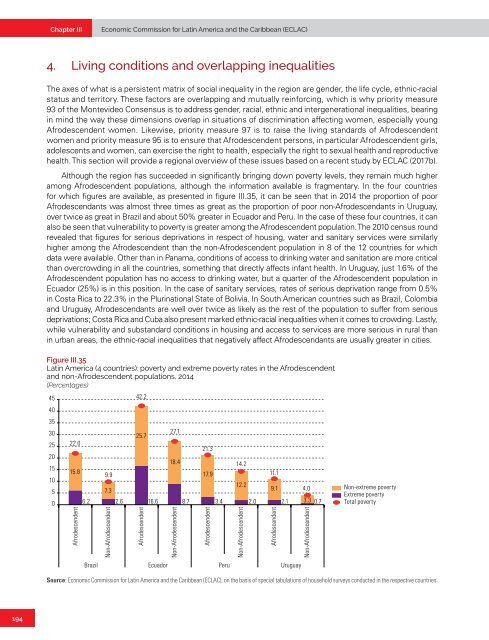Draft first regional report on the implementation of the Montevideo Consensus on Population and Development
This draft report seeks to give an account of progress in the implementation of the priority measures of the Montevideo Consensus on Population and Development in the region, as well as the differences between countries in terms of the degree of implementation. By highlighting relevant national experiences, it also seeks to facilitate the exchange of good practices among countries so that they can benefit from each other in their efforts to advance the implementation of the actions of the Montevideo Consensus.
This draft report seeks to give an account of progress in the implementation of the priority measures of the Montevideo Consensus on Population and Development in the region, as well as the differences between countries in terms of the degree of implementation. By highlighting relevant national experiences, it also seeks to facilitate the exchange of good practices among countries so that they can benefit from each other in their efforts to advance the implementation of the actions of the Montevideo Consensus.
Create successful ePaper yourself
Turn your PDF publications into a flip-book with our unique Google optimized e-Paper software.
Chapter III<br />
Ec<strong>on</strong>omic Commissi<strong>on</strong> for Latin America <strong>and</strong> <strong>the</strong> Caribbean (ECLAC)<br />
4. Living c<strong>on</strong>diti<strong>on</strong>s <strong>and</strong> overlapping inequalities<br />
The axes <strong>of</strong> what is a persistent matrix <strong>of</strong> social inequality in <strong>the</strong> regi<strong>on</strong> are gender, <strong>the</strong> life cycle, ethnic-racial<br />
status <strong>and</strong> territory. These factors are overlapping <strong>and</strong> mutually reinforcing, which is why priority measure<br />
93 <strong>of</strong> <strong>the</strong> M<strong>on</strong>tevideo C<strong>on</strong>sensus is to address gender, racial, ethnic <strong>and</strong> intergenerati<strong>on</strong>al inequalities, bearing<br />
in mind <strong>the</strong> way <strong>the</strong>se dimensi<strong>on</strong>s overlap in situati<strong>on</strong>s <strong>of</strong> discriminati<strong>on</strong> affecting women, especially young<br />
Afrodescendent women. Likewise, priority measure 97 is to raise <strong>the</strong> living st<strong>and</strong>ards <strong>of</strong> Afrodescendent<br />
women <strong>and</strong> priority measure 95 is to ensure that Afrodescendent pers<strong>on</strong>s, in particular Afrodescendent girls,<br />
adolescents <strong>and</strong> women, can exercise <strong>the</strong> right to health, especially <strong>the</strong> right to sexual health <strong>and</strong> reproductive<br />
health. This secti<strong>on</strong> will provide a <str<strong>on</strong>g>regi<strong>on</strong>al</str<strong>on</strong>g> overview <strong>of</strong> <strong>the</strong>se issues based <strong>on</strong> a recent study by ECLAC (2017b).<br />
Although <strong>the</strong> regi<strong>on</strong> has succeeded in significantly bringing down poverty levels, <strong>the</strong>y remain much higher<br />
am<strong>on</strong>g Afrodescendent populati<strong>on</strong>s, although <strong>the</strong> informati<strong>on</strong> available is fragmentary. In <strong>the</strong> four countries<br />
for which figures are available, as presented in figure III.35, it can be seen that in 2014 <strong>the</strong> proporti<strong>on</strong> <strong>of</strong> poor<br />
Afrodescendants was almost three times as great as <strong>the</strong> proporti<strong>on</strong> <strong>of</strong> poor n<strong>on</strong>-Afrodescendants in Uruguay,<br />
over twice as great in Brazil <strong>and</strong> about 50% greater in Ecuador <strong>and</strong> Peru. In <strong>the</strong> case <strong>of</strong> <strong>the</strong>se four countries, it can<br />
also be seen that vulnerability to poverty is greater am<strong>on</strong>g <strong>the</strong> Afrodescendent populati<strong>on</strong>. The 2010 census round<br />
revealed that figures for serious deprivati<strong>on</strong>s in respect <strong>of</strong> housing, water <strong>and</strong> sanitary services were similarly<br />
higher am<strong>on</strong>g <strong>the</strong> Afrodescendent than <strong>the</strong> n<strong>on</strong>-Afrodescendent populati<strong>on</strong> in 8 <strong>of</strong> <strong>the</strong> 12 countries for which<br />
data were available. O<strong>the</strong>r than in Panama, c<strong>on</strong>diti<strong>on</strong>s <strong>of</strong> access to drinking water <strong>and</strong> sanitati<strong>on</strong> are more critical<br />
than overcrowding in all <strong>the</strong> countries, something that directly affects infant health. In Uruguay, just 1.6% <strong>of</strong> <strong>the</strong><br />
Afrodescendent populati<strong>on</strong> has no access to drinking water, but a quarter <strong>of</strong> <strong>the</strong> Afrodescendent populati<strong>on</strong> in<br />
Ecuador (25%) is in this positi<strong>on</strong>. In <strong>the</strong> case <strong>of</strong> sanitary services, rates <strong>of</strong> serious deprivati<strong>on</strong> range from 0.5%<br />
in Costa Rica to 22.3% in <strong>the</strong> Plurinati<strong>on</strong>al State <strong>of</strong> Bolivia. In South American countries such as Brazil, Colombia<br />
<strong>and</strong> Uruguay, Afrodescendants are well over twice as likely as <strong>the</strong> rest <strong>of</strong> <strong>the</strong> populati<strong>on</strong> to suffer from serious<br />
deprivati<strong>on</strong>s; Costa Rica <strong>and</strong> Cuba also present marked ethnic-racial inequalities when it comes to crowding. Lastly,<br />
while vulnerability <strong>and</strong> subst<strong>and</strong>ard c<strong>on</strong>diti<strong>on</strong>s in housing <strong>and</strong> access to services are more serious in rural than<br />
in urban areas, <strong>the</strong> ethnic-racial inequalities that negatively affect Afrodescendants are usually greater in cities.<br />
Figure III.35<br />
Latin America (4 countries): poverty <strong>and</strong> extreme poverty rates in <strong>the</strong> Afrodescendent<br />
<strong>and</strong> n<strong>on</strong>-Afrodescendent populati<strong>on</strong>s, 2014<br />
(Percentages)<br />
45<br />
42.2<br />
40<br />
35<br />
30<br />
25<br />
20<br />
15<br />
10<br />
5<br />
0<br />
22.0<br />
25.7<br />
27.1<br />
18.4<br />
14.2<br />
15.8<br />
9.9<br />
17.9<br />
11.1<br />
12.2<br />
7.3<br />
9.1 4.0<br />
6.2 2.6 16.6 8.7 3.4 2.0 2.1 3.3 0.7<br />
Afrodescendent<br />
N<strong>on</strong>-Afrodescendent<br />
Afrodescendent<br />
N<strong>on</strong>-Afrodescendent<br />
21.3<br />
Afrodescendent<br />
N<strong>on</strong>-Afrodescendent<br />
Afrodescendent<br />
N<strong>on</strong>-Afrodescendent<br />
N<strong>on</strong>-extreme poverty<br />
Extreme poverty<br />
Total poverty<br />
Brazil Ecuador Peru Uruguay<br />
Source: Ec<strong>on</strong>omic Commissi<strong>on</strong> for Latin America <strong>and</strong> <strong>the</strong> Caribbean (ECLAC), <strong>on</strong> <strong>the</strong> basis <strong>of</strong> special tabulati<strong>on</strong>s <strong>of</strong> household surveys c<strong>on</strong>ducted in <strong>the</strong> respective countries.<br />
194


















